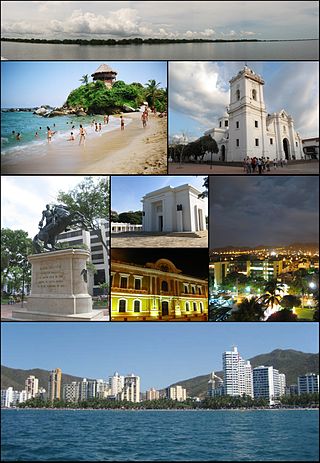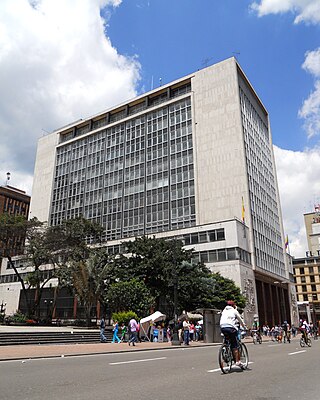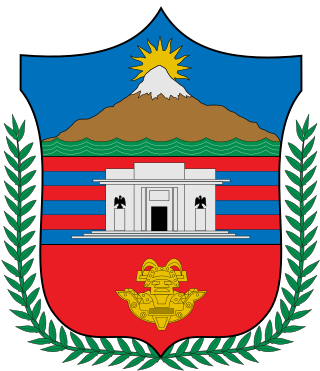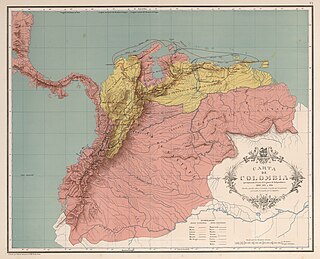
Magdalena is a department of Colombia with more than 1.3 million people, located to the north of the country by the Caribbean Sea. The capital of the Magdalena Department is Santa Marta and was named after the Magdalena River. It inherited the name of one of the original nine states of the United States of Colombia that its current territory integrated.

Santa Marta, officially the Distrito Turístico, Cultural e Histórico de Santa Marta, is a city on the coast of the Caribbean Sea in northern Colombia. It is the capital of Magdalena Department and the fourth-largest urban city of the Caribbean Region of Colombia, after Barranquilla, Cartagena, and Soledad. Founded on July 29, 1525, by the Spanish conqueror Rodrigo de Bastidas, it was one of the first Spanish settlements in Colombia, its oldest surviving city, and second oldest in South America. This city is situated on a bay by the same name and as such, it is a prime tourist destination in the Caribbean region.

The Magdalena River is the main river of Colombia, flowing northward about 1,528 kilometres (949 mi) through the western half of the country. It takes its name from the biblical figure Mary Magdalene. It is navigable through much of its lower reaches, in spite of the shifting sand bars at the mouth of its delta, as far as Honda, at the downstream base of its rapids. It flows through the Magdalena River Valley.

Aracataca is a town and municipality and town located in the Department of Magdalena, in Colombia's Caribbean Region. Aracataca is a river town founded in 1885. The town stands beside a small river of the same name, the Aracataca river, that flows from the nearby Sierra Nevada de Santa Marta mountain range into the Ciénaga Grande de Santa Marta, a lagoon of the Caribbean Sea. Aracataca is 80 kilometres (50 mi) south of the Department capital Santa Marta. The town is best known as the birthplace of Nobel literature laureate Gabriel García Márquez.

A dolphinarium is an aquarium for dolphins. The dolphins are usually kept in a pool, though occasionally they may be kept in pens in the open sea, either for research or public performances. Some dolphinaria consist of one pool where dolphins perform for the public, others are part of larger parks, such as marine mammal parks, zoos or theme parks, with other animals and attractions as well.

The Museum of Gold is an archaeology museum located in Bogotá, Colombia. It is one of the most visited touristic highlights in the country. The museum receives around 500,000 tourists per year.

The Museo Casa de Moneda is a numismatics museum located in La Candelaria neighborhood of Bogotá, Colombia. It is managed by the Bank of the Republic of Colombia and used to display its numismatic collection that is composed by around 18,600 objects that include artwork, banknotes, bonds, coins, derivatives, medals, negotiable instruments, and printing instruments from various time periods and regions of the world.

The Bank of the Republic is the central bank of Colombia. It was initially established under the regeneration era in 1880. Its main modern functions, under the new Colombian constitution were detailed by Congress according to Ley 31 de 1992. One of them is the issuance of the Colombian currency, the peso. The bank is also active in promoting financial inclusion policy and is a leading member of the Alliance for Financial Inclusion.

The coat of arms of Magdalena is the official coat of arms of the Colombian department of Magdalena. It was officially adopted by the Departmental Assembly out of the winning design presented by native painter Álvaro Corvacho.

Simón Bolívar International Airport is an international airport serving the city of Santa Marta, Colombia. The airport is located 14 kilometres (8.7 mi) south of Santa Marta city center, on the shores of the Caribbean Sea. 18 kilometres (11 mi) north of the municipality of Ciénaga in Colombia.

The Paja Formation is an Early Cretaceous geologic formation of central Colombia. The formation extends across the northern part of the Altiplano Cundiboyacense, the Western Colombian emerald belt and surrounding areas of the Eastern Ranges of the Colombian Andes. In the subsurface, the formation is found in the Middle Magdalena Valley to the west. The Paja Formation stretches across four departments, from north to south the southernmost Bolívar Department, in Santander, Boyacá and the northern part of Cundinamarca. Well known fossiliferous outcrops of the formation occur near Villa de Leyva, also written as Villa de Leiva, and neighboring Sáchica.

The Magdalena campaign was a military operation from late 1812 to early 1813, led by the independentists Simón Bolívar and Pierre Labatut against royalists and the crown of Spain in New Granada. The campaign resulted in the revolutionary United Provinces of New Grenada taking control of the Magdalena River, which connects the port city of Cartagena with the interior of Colombia.

The Bucaramanga-Santa Marta Fault or Bucaramanga-Santa Marta Fault System is a major oblique transpressional sinistral strike-slip fault in the departments of Magdalena, Cesar, Norte de Santander and Santander in northern Colombia. The fault system is composed of two main outcropping segments, named Santa Marta and Bucaramanga Faults, and an intermediate Algarrobo Fault segment in the subsurface. The system has a total length of 674 kilometres (419 mi) and runs along an average north-northwest to south-southeast strike of 341 ± 23 from the Caribbean coast west of Santa Marta to the northern area of the Eastern Ranges of the Colombian Andes.
The volleyball tournaments, for the 2017 Bolivarian Games in Santa Marta, Colombia were held in the U-23 category between 12 and 23 November 2017 at Coliseo Municipal in Ciénaga, Magdalena.

La Guajira Terrane is one of the geological provinces (terranes) of Colombia. The terrane, dating to the Late Cretaceous, is situated on the North Andes Plate and borders the Caribbean, Tahamí and Chibcha Terranes along the Bucaramanga-Santa Marta Fault. The southern boundary is formed by the Oca Fault with the Chibcha Terrane.

The Noreán Formation is a geological formation of the Eastern Ranges of the Colombian Andes, the Serranía de San Lucas and as basement underlying the southernmost Lower and northern Middle Magdalena Valleys. The formation consists of volcanic and pyroclastic lavas that range from andesites to rhyolites. Vitric, lithic and crystal tuffs and andesitic dikes and hypabyssal bodies are also present in the formation.

The Miguel Urrutia Art Museum (Spanish: Museo de Arte Miguel Urrutia (MAMU)) is an art museum in Bogotá, Colombia.


















